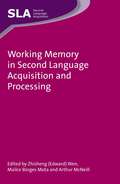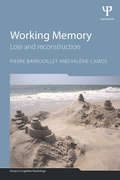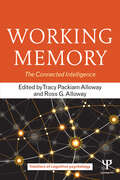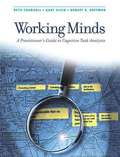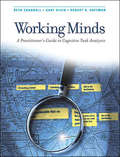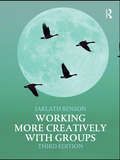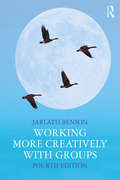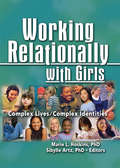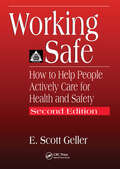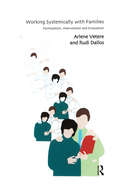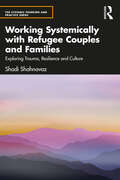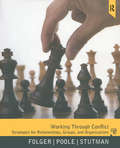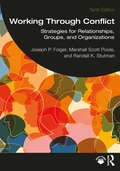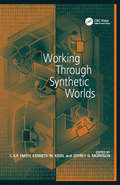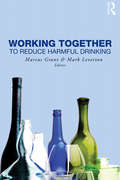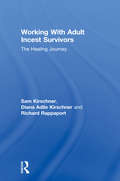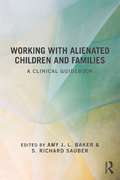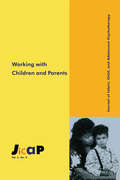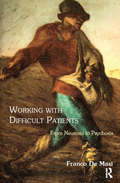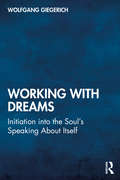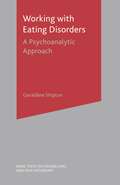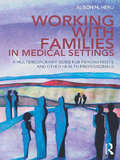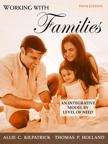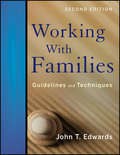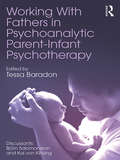- Table View
- List View
Working Memory in Second Language Acquisition and Processing
by Zhisheng Edward Wen Mailce Borges MotaThis unique volume offers a comprehensive discussion of essential theoretical and methodological issues concerning the pivotal role of working memory in second language learning and processing. The collection opens with a foreword and introductory theoretical chapters written by leading figures in the field of cognitive psychology. Following these are three research sections containing chapters providing original data and innovative insights into the dynamic and complex relationships between working memory and specific areas of second language processing, instruction, performance and development. Each section concludes with a commentary which is written by a noted SLA researcher and which charts the course for future research. This book provides a fascinating collection of perspectives on the relationship between working memory and second language learning and will appeal to those interested in the integration of cognitive psychology with SLA research.
Working Memory: Loss and reconstruction (Essays in Cognitive Psychology)
by Valérie Camos Pierre BarrouilletWorking memory is the cognitive system in charge of the temporary maintenance of information in view of its on-going processing. Lying at the centre of cognition, it has become a key concept in psychological science. The book presents a critical review and synthesis of the working memory literature, and also presents an innovative new theory - the Time-Based Resource-Sharing (TBRS) model. Tracing back the evolution of the concept of working memory, from its introduction by Baddeley and Hitch in 1974 and the development of their modal model, Barrouillet and Camos explain how an alternative conception could have been developed from the very beginning, and why it is needed today. This alternative model takes into account the temporal dynamics of mental functioning. The book describes a new architecture for working memory, and provides a description of its functioning, its development, the sources of individual differences, and hints about neural substrates. The authors address central and debated questions about working memory, and also more general issues about cognitive architecture and functioning. Working Memory: Loss and Reconstruction will be essential reading for advanced students and researchers of the psychology of memory.
Working Memory: The Connected Intelligence (Frontiers of Cognitive Psychology)
by Tracy Packiam Alloway Ross G. AllowayWorking memory – the conscious processing of information – is increasingly recognized as one of the most important aspects of intelligence. This fundamental cognitive skill is deeply connected to a great variety of human experience – from our childhood, to our old age, from our evolutionary past, to our digital future. In this volume, leading psychologists review the latest research on working memory and consider what role it plays in development and over the lifespan. It is revealed how a strong working memory is connected with success (academically and acquiring expertise) and a poor working memory is connected with failure (addictive behavior and poor decision-making). The contributions also show how working memory played a role in our cognitive evolution and how the everyday things we do, such as what we eat and how much we sleep, can have an impact on how well it functions. Finally, the evidence on whether or not working memory training is beneficial is explored. This volume is essential reading for students, researchers, and professionals with an interest in human memory and its improvement, including those working in cognitive psychology, cognitive neuroscience, developmental psychology, gerontology, education, health, and clinical psychology.
Working Minds
by Gary Klein Robert R. Hoffman Beth CrandallCognitive Task Analysis (CTA) helps researchers understand how cognitive skills and strategies make it possible for people to act effectively and get things done. CTA can yield information people need -- employers faced with personnel issues, market researchers who want to understand the thought processes of consumers, trainers and others who design instructional systems, health care professionals who want to apply lessons learned from errors and accidents, systems analysts developing user specifications, and many other professionals. CTA can show what makes the workplace work -- and what keeps it from working as well as it might. Working Minds is a true handbook, offering a set of tools for doing CTA: methods for collecting data about cognitive processes and events, analyzing them, and communicating them effectively. It covers both the "why" and the "how" of CTA methods, providing examples, guidance, and stories from the authors' own experiences as CTA practitioners. Because effective use of CTA depends on some conceptual grounding in cognitive theory and research -- on knowing what a cognitive perspective can offer -- the book also offers an overview of current research on cognition.The book provides detailed guidance for planning and carrying out CTA, with chapters on capturing knowledge and capturing the way people reason. It discusses studying cognition in real-world settings and the challenges of rapidly changing technology. And it describes key issues in applying CTA findings in a variety of fields. Working Minds makes the methodology of CTA accessible and the skills involved attainable.
Working Minds: A Practitioner's Guide to Cognitive Task Analysis
by Robert R. Hoffman Beth Crandall Gary A. KleinHow to collect data about cognitive processes and events, how to analyze CTA findings, and how to communicate them effectively: a handbook for managers, trainers, systems analysts, market researchers, health professionals, and others.Cognitive Task Analysis (CTA) helps researchers understand how cognitive skills and strategies make it possible for people to act effectively and get things done. CTA can yield information people need—employers faced with personnel issues, market researchers who want to understand the thought processes of consumers, trainers and others who design instructional systems, health care professionals who want to apply lessons learned from errors and accidents, systems analysts developing user specifications, and many other professionals. CTA can show what makes the workplace work—and what keeps it from working as well as it might.Working Minds is a true handbook, offering a set of tools for doing CTA: methods for collecting data about cognitive processes and events, analyzing them, and communicating them effectively. It covers both the "why" and the "how" of CTA methods, providing examples, guidance, and stories from the authors' own experiences as CTA practitioners. Because effective use of CTA depends on some conceptual grounding in cognitive theory and research—on knowing what a cognitive perspective can offer—the book also offers an overview of current research on cognition.The book provides detailed guidance for planning and carrying out CTA, with chapters on capturing knowledge and capturing the way people reason. It discusses studying cognition in real-world settings and the challenges of rapidly changing technology. And it describes key issues in applying CTA findings in a variety of fields. Working Minds makes the methodology of CTA accessible and the skills involved attainable.
Working More Creatively with Groups
by Jarlath BensonA new edition of the classic group work textbook! In Working More Creatively with Groups, Jarlath Benson presents the essential knowledge required to set up and work with a group. He looks at how to plan and lead a group successfully and how to intervene skilfully. As well as covering the different stages in the life of a group, the book emphasizes the various levels of group experience and gives suggestions for working imaginatively with them. This thoroughly updated third edition not only provides a comprehensive guide to groupwork but shows the groupworker how to move on to more in-depth and intensive work, using a variety of strategies illustrated by full clinical vignettes. Many chapters are updated and expanded to include Benson’s latest thinking and teaching and the book includes two new chapters. The first focuses on working with and developing different sorts of groups along the therapeutic/educational continuum. The second new chapter discusses how to best use a supervisory process and set up and run a supervisory group. Well known and widely used by social workers, psychologists, educationalists and youth workers, this popular text is suitable for all those working with groups.
Working More Creatively with Groups
by Jarlath BensonIn this classic text Jarlath Benson presents the basic and essential knowledge required to set up and work with a group. He looks at how to plan and lead a group successfully and how to intervene skilfully. As well as covering the different stages in the life of a group, the book emphasizes the various levels of group experience and gives suggestions for working more creatively with them. For this new edition the author has added two new chapters reflecting how his own thinking and practice have developed since the book was first published. In the first he presents his new model for planning, setting up and working with reflective practice groups which are increasingly used in professional settings and agencies across the public sector and health care. In the second he considers why some groups fail and offers practical and helpful ideas and insights to guide agencies and groupworkers to think and plan more systemically, and provides a series of clinical vignettes that facilitates each of these contexts and perspectives. There is also an expanded section on how to plan and conduct the sophisticated art of co-working and again a series of clinical vignettes that illustrate best practice. Working More Creatively with Groups is well known to countless social workers, psychologists, teachers and community workers and many other professionals who utilize and employ groupwork in their practice. This new edition not only provides the basic guide to groupwork but also shows how to move on to more in-depth and intensive work.
Working Relationally with Girls: Complex Lives/Complex Identities
by Marie L. Hoskins Sibylle ArtzDiscover how girls develop a sense of self as they struggle to make sense of complexand complicated timesWorking Relationally with Girls: Complex Lives, Complex Identities examines the experience of being a girl in today&’s society and the difficulties social work practitioners face in developing a universal theory that represents that experience. This unique book analyzes how-and why-gender is still a complicated barrier for most girls, despite living in "post-feminist" times. Working from a variety of orientations, the book offers practical suggestions on how to help girls deal with interpersonal tensions, interpersonal conflicts, relational dilemmas, and the difficulties that stem from rules and norms of what is still a male-dominated society.Human service practitioners, regardless of their fields, face an everyday struggle to understand how adolescent girls construct identities in relation to the culture in which they live. The contributors to Working Relationally with Girls call on a range of disciplines, including child and youth care, cultural studies, feminist theory, counseling, and social psychology, to examine how girls interpret cultural expectations to develop a sense of self under complex conditions. This unique book addresses the subtle-and not-so-subtle-practices (symbols, metaphors, images, scripts, rules, norms, and narratives) that shape girls&’ lives, providing the tools to build a basic framework that will help you understand how girls are alike-and how they&’re different. Working Relationally with Girls examines: how mothers and daughters perceive general differences regarding sexual experiences in adolescence how girls&’ health issues are constructed within the context of their dating relationships what do mothers and daughters want to know about each other&’s sexuality the difficulty girls have in articulating their needs and desires in romantic relationships how many girls deal with what they see as an impossible choice-compromising their sense of self to maintain a relationship or compromising the relationship to maintain their sense of self how the dynamics of a dating relationship can affect a girl&’s development and health the influence of media on constructing an identity how minorities form an identity when dealing with exclusion and belonging in a predominately white community using theater to examine the experience of identity formation and much more!Working Relationally with Girls is an essential guide to understanding how girls make sense of the world and how their decisions affect their gender and identity development. Social workers, health care professionals, child and youth care practitioners, and counselors will find this rich combination of theory and practice invaluable as an everyday resource.
Working Safe: How to Help People Actively Care for Health and Safety, Second Edition
by E. Scott GellerWritten by world-renowned health and safety researcher E. Scott Geller, Working Safe: How to Help People Actively Care for Health and Safety, Second Edition presents science-based and practical approaches to improving attitudes and behavior for achieving an injury-free work environment. This book teaches proactive applications of behavior-based psychology for improving health and safety. Relevant theory and principles are clearly explained and practical step-by-step procedures are detailed. Dr. Geller's anecdotal and non-academic writing style makes the book fun and easy to read.This research-based text is completely updated and expanded from the 1996 edition. It includes three new chapters: one on behavioral safety analysis, another on intervening with supportive conversation, and the third on how to promote high performance teamwork. Thus, this second edition continues to provide the practical advice safety leaders rely on.Working Safe: How to Help People Actively Care for Health and Safety supplies the research and theory needed to customize effective behavior-based procedures and tools in your workplace. The information and examples provide health and safety professionals with behavioral science methods capable of enhancing safety awareness, reducing at-risk behavior, and facilitating ongoing participation in safety-related activities.
Working Systemically with Families: Formulation, Intervention and Evaluation
by Rudi Dallos Arlene VetereSystemic theory offers a valuable framework for integrating the diverse ideas found throughout the mental health arena in both theory and clinical practice. With this accessible book, the authors take you on an enjoyable and coherent journey through systemic theory. They then review the body of research into family therapy and conclude with a critical review of major recent developments in theory and application. At the end of several chapters are reflexive notes containing exercises that relate to the ideas and processes found within the chapter to further develop the reader's understanding. The conclusion draws together the ideas found throughout the book, with particular emphasis on the interlocking triangle of formulation, intervention and evaluation and how this will impact on systemic practice in the future. While this book will be an invaluable introduction to family systems theory and practice for clinical psychology training courses, plugging a gap that the authors have identified as one of their motives for writing it, its remit runs much wider. It will prove an essential companion for any professional working in the public services, whether systemically trained or not.
Working Systemically with Refugee Couples and Families: Exploring Trauma, Resilience and Culture (The Systemic Thinking and Practice Series)
by Shadi ShahnavazThis stirring and insightful book explores how family dynamics among refugees are affected by the trauma of forced migration. Written by an experienced family therapist, it uses a systemic perspective to understand the impact on couple relationships and parenting, as well as the broader issue of cultural and social assimilation. Shedding light on the complex and relational nature of the trauma experienced by refugee families, including issues around gender and mental health, Shadi Shahnavaz examines the clinical implications for those who care for them. The unique, in-depth interviews with refugees provide a rare insight into their journey to England and the adverse experiences they encounter along the way. Rather than a simple reflection on practice, Shahnavaz invites the reader to think about the ways in which they can connect with others, even in challenging and unfamiliar situations. Working Systemically with Refugee Couples and Families is essential reading for any therapist or counsellor working today.
Working Through Conflict: Strategies for Relationships, Groups, and Organizations
by Marshall Scott Poole Joseph Folger Randall K. StutmanUpdated in its 7th edition, Working Through Conflict provides an introduction to conflict and conflict management that is firmly grounded in current theory, research, and practice, covering the whole range of conflict settings (interpersonal, group, and organizational). Encompassing a broad spectrum of theoretical perspectives, the text includes an abundance of real life case studies that illustrate key concepts and help students learn how to apply theory. The book's emphasis on application of concepts makes it highly accessible to students, while expanding their understanding of both conflict theory and practical skills.An introduction to social science research and theory on conflict
Working Through Conflict: Strategies for Relationships, Groups, and Organizations
by Marshall Scott Poole Randall K. Stutman Joseph P. FolgerEncompassing theory, research, and practice, this tenth edition provides an introduction to conflict communication and conflict management. This text features real-life case studies across a range of theoretical perspectives and conflict settings, including interpersonal, group, and organizational. Approachably written for students and with an eye to application, the book teaches conflict theory in the context of practical skills. This edition features new sections and references on recognizing intractable conflict and managing online conflict, a new exhibit on conflict escalation, and a new section on interpersonal goals, as well as an updated list of powerful ways to resolve and manage conflict.This textbook is ideally suited to undergraduate or graduate courses on conflict communication within communication studies, business and management, political science, and counseling programs. An Instructor’s Manual, including a sample syllabus, written and oral assignments, cases, exercises, video and online resources, sections from previous editions, and test questions is available at www.routledge.com/9781032489186.
Working Through Synthetic Worlds
by Kenneth W. KisielVirtual environments (VE) are human-computer interfaces in which the computer creates a sensory-immersing environment that interactively responds to and is controlled by the behaviour of the user. Since these technologies will continue to become more reliable, more resolute and more affordable, it's important to consider the advantages that VEs may offer to support business processes. The term 'synthetic world' refers to a subset of VEs, having a large virtual landscape and a set of rules that govern the interactions among participants. Currently, the primary motivators for participation in these synthetic worlds appear to be fun and novelty. As the novelty wears off, synthetic worlds will need to demonstrate a favourable value proposition if they are to survive. In particular, non-game-oriented worlds will need to facilitate business processes to a degree that exceeds their substantial costs for development and maintenance. Working Through Synthetic Worlds explores a variety of different tasks that might benefit by being performed within a synthetic world. The editors use a distinctive format for the book, consisting of a set of chapters composed of three parts: ¢ a story or vignette that describes work conducted within a synthetic world based loosely on the question, 'what will work be like in the year 2025?', founded on the expert authors' expectations of plausible future technologies ¢ a scholarly review of the technologies described by the stories and the current theories related to those technologies ¢ a prescription for future research required to bridge the current state-of-the-art with the notional worlds described in the stories. The book will appeal to undergraduate and graduate students, professors, scientists and engineers, managers in high-tech industries and software developers.
Working Together to Reduce Harmful Drinking
by Marcus Grant Mark LevertonThis book is intended to contribute to the World Health Organization’s (WHO) global strategy to reduce the harmful use of alcohol. It explores areas where alcohol producers’ technical competence can and does make a positive contribution to reducing harmful drinking and where industry input has been welcomed by WHO. The book describes each of these areas: producing beer, wine, and spirits; addressing availability of noncommercial beverages; pricing, marketing, and selling beverage alcohol; encouraging responsible choices; and working with others. The final chapter sets out views of how alcohol producers can contribute to reducing harmful drinking in countries where they are present. The messages recurring throughout the book are that reasonable regulation provides the context for good alcohol policy, excessive regulation often leads to unintended negative consequences, leading producers have a proud record of making positive contributions to implementing effective alcohol policies - but there are opportunities to do much more.
Working With Adult Incest Survivors: The Healing Journey
by Sam Kirschner Diana Adile Kirschner Richard RappaportFirst published in 1993. Routledge is an imprint of Taylor & Francis, an informa company.
Working With Alienated Children and Families: A Clinical Guidebook
by Amy J. L. Baker S. Richard SauberThis edited volume is written by and for mental health professionals who work directly with alienated children and their parents. The chapters are written by leaders in the field, all of whom know how vexing parental alienation can be for mental health professionals. No matter how the professional intersects with families affected by alienation, be it through individual treatment, reunification therapy, a school setting, or support groups, he or she needs to consider how to make proper assessments, how to guard against bias, and when and how to involve the court system, among other challenges. The cutting edge clinical interventions presented in this book will help professionals answer these questions and help them to help their clients. The authors present a range of clinical options such as parent education, psycho-educational programs for children, and reunification programs for children and parents that make this volume a useful reference and practical guide.
Working With Children: Journal of Infant, Child, and Adolescent Psychotherapy, 2.2
by Kirkland C. VaughansThis is a special issue of JICAP looking at working with children and parents.
Working With Difficult Patients: From Neurosis to Psychosis
by Franco De MasiIn this book the author examines the series of connections that give rise to the intimate relationship between environment and individual in the construction of emotional suffering, emphasising both the undisputed pathogenic action of environmental stimuli and the active participation of whoever is obliged to suffer the negative situation. The author shows that the way in which one tries to escape suffering is what often seriously jeopardises growth. Working with Difficult Patients points out the intrinsic link between some forms of mental suffering and the distorted responses that the patient has received from his or her original environment. For this reason the author explores the concept of the emotional trauma in particular, since this trauma, which occurs in the primary relationship, often impels the child into relational withdrawal and towards constructing pathological structures that will accompany him or her for the rest of their life. The chapters are ordered according to a scale of increasing treatment difficulty, which is proportional to the potential pathogenicity of the underlying psychopathological structure.
Working With Dreams: Initiation into the Soul’s Speaking About Itself
by Wolfgang GiegerichThis book is about the practice of working with dreams. Rather than presenting a general theory about dreams, it focuses on the dream as phenomenon and raises the question how we must look at dreams if our approach is supposed to be a truly psychological one. So far most essays on, and the practice of, Jungian dream interpretation have paradoxically centered around the person of the dreamer and not around the dream itself. Dreams were used as a means to understand the analysand and what is going on in him or her. Jung’s fundamental shift from his earlier person-based psychology and pre-alchemy stance to his mature soul-based psychology, informed by the hermetic logic of alchemy, has not been followed, which was already noted by Jung himself: "My later and more important work (as it seems to me) is still left untouched in its primordial obscurity." The present study is based decidedly on the stance of mature Jung and his very different views about dreams. His most crucial insights in this regard include that in dreams the soul speaks about itself (not about the dreamer), that the dream is its own interpretation and therefore needs to be circumambulated (rather than translated into the language of psychology and everyday life), and that dream images have everything they need within themselves (rather than needing associations from the dreamerʼs daily life). This book discusses in detail what all this means in practice and what it demands of the psychologist. A decisive transposition away from ordinary consciousness, a "crossing to the other side of the river," is required of the consciousness that wants to approach dreams psychologically. Numerous aspects of dreams and special questions that come up in working with dreams are discussed. At the end of this book our working with dreams is situated in the wider question of the psychological task in general by exploring Jungʼs insistence that psychology has to transcend the "consulting room," Hillman’s move "From mirror to window" and, in Plato’s parable, the revolutionary move out of, and return to, "the cave." While limited to the topic of dreams this book may also serve as an indirect introduction to an understanding of psychology as a "psychology with soul" (Jung) or as the discipline of interiority.
Working With Eating Disorders: A Psychoanalytic Approach (Basic Texts in Counselling and Psychotherapy)
by Geraldine ShiptonEating disorders such as anorexia and bulimia are increasingly prevalent in today's society and of great concern to a wide range of health-related professionals, including counsellors and psychotherapists. This important new text, written in an intelligent yet accessible style, provides an authoritative and practical introduction to therapeutic work with this large client group. Taking a psychodynamic approach, Working with Eating Disorders also embraces an appreciation of cultural influences and uniquely illustrates the context of eating disorders in today's society.
Working With Families in Medical Settings: A Multidisciplinary Guide for Psychiatrists and Other Health Professionals
by Alison M. HeruWorking With Families in Medical Settings provides mental-health professionals with the tools they need to figure out what patients and families want and how, within the constraints imposed by 21st-century healthcare setting, to best give them the care they need. Psychiatrists and other clinicians who work in medical settings know that working with a patient with a chronic illness usually entails work with that patient’s family as well as with other medical professionals. Some families need education; others have specific difficulties or dysfunctions that require skilled assessment and intervention. It is up to the clinician to find productive ways to work with common themes in family life: expressed emotion, levels of resilience, life-cycle issues, and adaptation to illness, among others. Enter Working With Families in Medical Settings, which shines a spotlight on the major issues professional caregivers face and shows them how to structure an effective intervention in all kinds of settings. Psychiatrists, particularly those in psychosomatic medicine, and other clinicians who work with the medically ill will find Working With Families in Medical Settings to be an essential resource and guide to productive relationships with patients and their families.
Working With Families: An Integrative Model By Level Of Need (Fifth Edition)
by Allie C. Kilpatrick Thomas P. HollandThis text focuses on all levels of need within a family, and provides clear guidelines for effective family interventions. The authors emphasize family strengths, coping capacities, and the many commonalities shared by all. All levels of need are addressed and practice models are applied, highlighting the importance of looking at the specific needs of each family and the effective practice interventions.
Working With Families: Guidelines and Techniques
by John T. EdwardsA complete guide for helping professionals, with tried-and-true techniques for practicing family counseling therapyNow in its second edition, Working With Families: Guidelines and Techniques is filled with up-to-date, systems-oriented techniques focused on field-tested results. Outlining the dos and don'ts of working with different types of families and the various complications, nuances, and complexities that can occur, this practical guide provides a broad and proven selection of interventions, processes, and guidelines for working interactively, systematically, and compassionately with families.Working With Families, Second Edition covers a range of topics including:Family work in different settingsSession-by-session guidelinesTherapeutic themes by family typeManaging adolescents in family sessionsDealing with fear of family workFamily mappingStrategic child assessmentChemical dependence and its impact on familiesInformed by the author's many years of experience in the field, both as a clinician and as a trainer, Working With Families, Second Edition offers an invaluable systems-oriented, goal-directed, problem-solving approach to family counseling therapy for all mental health professionals.
Working With Fathers in Psychoanalytic Parent-Infant Psychotherapy
by Tessa BaradonWorking With Fathers in Psychoanalytic Parent-Infant Psychotherapy interfaces theoretical ideas about fatherhood and their incorporation into the clinical practice of psychoanalytic parent-infant psychotherapy. Often, when a family attends parent-infant psychotherapy, issues of the father are eclipsed by attention to the mother, who is usually the identified patient. Until now relatively neglected in the literature, this book attends to both the barriers to psychological work with the father, and to ways in which he can be engaged in a therapeutic process. In this book, Tessa Baradon brings together some of the most eminent clinicians and academics in the field of parent-infant psychotherapy, in a layered collection of theoretical and clinical contributions. She and her co-discussants, Björn Salomonsson and Kai von Klitzing, conclude with an integration and critique of the themes presented, exploring the ideas of their fellow contributors and expanding on the central themes of the work. Working With Fathers in Psychoanalytic Parent-Infant Psychotherapy will be of interest to mental health practitioners working with infants, who will learn that each individual and the family as a system can benefit from such an inclusive approach.
